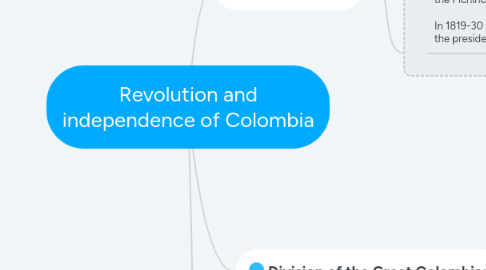Revolution and independence of Colombia
af MANUELA GARCIA


1. Independence:
1.1. In 1808 in New Granada there were conflicts by colonial and peninsular subjects for having control of the government, provoking declarations of independence. In 1810 the jurisdictions expelled Spanish officials, except in Santa Marta, Riohacha, Panama, Bogotá and Ecuador. Also in that year the Independence Day in Colombia was commemorated, although the declaration was until 181. In 1814 and 1816 the Spanish reconquest was facilitated, and the republican forces fled and reorganized under Francisco de Paula Santander. And later they would join Simón Bolívar in Orinoco Venezuela. In 1819 Bolívar defeated the Spanish forces on August 7 in Boyacá, arrangements were also made for the new government and the constitution. In 1821 was the battle of Carabobo, in 1822 the Pichincha, Ecuador and in 1823 the forces went to Peru. In 1819-30 the bases for the Republic of Colombia were formed and it was achieved in 1821 in the congress of Cúcuta, achieving a centralized government, with regional vice presidents and the president of that time Bolívar. Thus pleased the creole leaders who sought to centralize the authority, unlike the idealists and provincial leaders who wanted the federation.
2. Division of the Great Colombia:
2.1. The Great Colombia lasted a short time, since in 1826 Venezuela separated from the great Colombia and was directed by José Antonio Páez, after the separation from Venezuela spread the discontent and it did not take long for the great Colombia to be divided in 1829 in four, then in 1830 New Granada (Colombia and Panama) was constituted during the constitution Bolivar resigned to die in Santa Marta on December 17, 1830.
3. Republic Until 1930:
3.1. Republic until 1930 In 1830 it was a time of prosperity, until 1840 where the discord between liberators and conservatives began to grow, affecting commerce and local businesses. The bloody revolution devastated the country between 1840 and 1903.
3.2. Separation of Panamá from Colombia:
3.2.1. Separation of Panama from Colombia. On November 21, 1902, in the Bay of Panama, liberals and conservatives reached the end of the conflict and the treaty that ended with the war of a thousand days that devastated Panama was drafted and signed. And in 1903, on May 15, a Panamanian guerrilla liberator was shot, since he refused to accept the terms, this helped spread the distrust of the Panamanian liberals against the Colombian conservatives and, that way, the separatist cause was reached.

